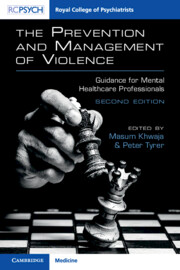Book contents
- The Prevention and Management of Violence
- The Prevention and Management of Violence
- Copyright page
- Dedication
- Contents
- Contributors
- Preface
- Abbreviations
- Section 1 General Aspects of Management
- Introduction to Section 1
- Chapter 1 The Need for a Common Set of Guidelines
- Chapter 2 Legislation Relevant to the Management of Violence by Persons With Mental Disorders
- Chapter 3 Protection and Safeguarding of Vulnerable Adults and Children Exposed to Violence
- Chapter 4 Anticipation and Reduction of Violence: Implications of the NICE 2015 Guideline
- Chapter 5 Post-Incident Management
- Section 2 Medical and Psychological Intervention
- Section 3 Violence in Different Settings
- Section 4 Management in Other Groups
- Section 5 Violence and Society
- Section 6 Engagement and Understanding
- Index
- References
Chapter 4 - Anticipation and Reduction of Violence: Implications of the NICE 2015 Guideline
from Section 1 - General Aspects of Management
Published online by Cambridge University Press: 09 May 2023
- The Prevention and Management of Violence
- The Prevention and Management of Violence
- Copyright page
- Dedication
- Contents
- Contributors
- Preface
- Abbreviations
- Section 1 General Aspects of Management
- Introduction to Section 1
- Chapter 1 The Need for a Common Set of Guidelines
- Chapter 2 Legislation Relevant to the Management of Violence by Persons With Mental Disorders
- Chapter 3 Protection and Safeguarding of Vulnerable Adults and Children Exposed to Violence
- Chapter 4 Anticipation and Reduction of Violence: Implications of the NICE 2015 Guideline
- Chapter 5 Post-Incident Management
- Section 2 Medical and Psychological Intervention
- Section 3 Violence in Different Settings
- Section 4 Management in Other Groups
- Section 5 Violence and Society
- Section 6 Engagement and Understanding
- Index
- References
Summary
This chapter concentrates on the advice given to NHS workers in the NICE guideline of 2015 and subsequent related advice from the National Institute of Care and Clinical Excellence. In the interests of transparency, we give the principles that lie behind NICE guidance that have only recently been published. In the NICE guideline we placed great emphasis on the prevention of violence and the reduction of all forms of restrictive intervention, and the reasoning behind this is given. We point out the major impact of the environment in both facilitating prevention of violence and, sadly, all too often in over-crowded NHS settings, promoting it. Advance directives, although rarely used at present, are likely to become more relevant and need to be highlighted. Finally, we address the thorny issue of risk. In our guideline we could not give advice on sound evidence; the situation has not changed since, and the dynamic elements of a potentially violent episode are more important to attend to than even the best of written guidance.
- Type
- Chapter
- Information
- The Prevention and Management of ViolenceGuidance for Mental Healthcare Professionals, pp. 52 - 62Publisher: Cambridge University PressPrint publication year: 2023

